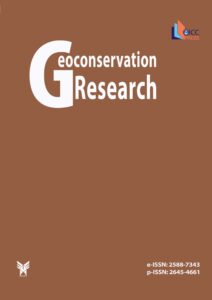Exposed! The Public Life of Carboniferous Fossils in the Burren and Cliffs of Moher UNESCO Global Geopark, Ireland
Authors
- Eamon Doyle * 1
Abstract
Carboniferous fossils from the Burren and Cliffs of Moher UNESCO Global Geopark, County Clare, Ireland are rated by their promotional potential in the form of celebrity A, B or C-listings. Trace fossils, crinoids, brachiopods, corals and vertebrates are the most exposed to public view at a number of high-profile visitor locations and the relative risk to the fossils to increased public exposure is assessed. The least abundant fossils, the vertebrates, have the highest promotional potential, while locally well-known trace fossils are also considered high potential. The invertebrates are of lower promotional value; however, that is changing with increasing public education. Currently, fossils get limited exposure on Geopark websites and social media platforms. The use of fossils to provide content to social media and other geotourism promotional material should be encouraged but requires a balance between the needs of geoconservation, scientific study and geotourism exploitation that requires selective use of fossils and careful promotional writing.
Read the full text of the articleKeywords
- Promotion
- Geotourism. Geoconservation
- Carboniferous fossils
- Burren and Cliffs of Moher UNESCO Global Geopark
- Social media
Main Subjects
References
Barham M, Murray J, Sevastopulo GD& Williams DM (2015). Conodonts of the genus Lochriea in Ireland and the recognition of the Viséan–Serpukhovian (Carboniferous) boundary. Lethaia. 48:151-171.
Bertoni D, Sarti G, Grottoli E, Ciavola P, Pozzebon A, Domokos G, Novák-Szabo T (2016). Impressive abrasion rates of marked pebbles on a coarse-clastic beach within a 13-month timespan. 381:175-180.
Bisat WS (1924). The Carboniferous goniatites of the north of England and their zones. Proceedings of the Yorkshire Geological Society. 20:40-124.
Donovan SKD & Doyle EN (2019). Utility of crinoid columnals in palaeontology illustrated by a new species: Clare Shale Formation (Carboniferous), Doolin, County Clare, Ireland. Proceedings of the Geologists Association. 130:696-700
Donovan SK. and Doyle E (2020). Significance of crinoid preservation: Clare Shale Formation (Upper Carboniferous), Fisherstreet Bay, Doolin, County Clare, Ireland. Proceedings of the Geologists’ Association. 131: 601–603.
Doyle E & O’Gogáin A (2019). Tetrapod bones from the Clare Shale Formation (Pennsylvanian, Bashkirian) of County Clare, Ireland. Irish Journal of Earth Sciences. 37:19-25.
Doyle E, Hennessy R, McNamara M & Hocter Z (2017). Stone, Water and Ice –A geology trip through the Burren. 3rd Edition. Published by the Burren and Cliffs of Moher UNESCO Global Geopark.132pp. ISBN: 0-9567204-2-9
Fallon P &Murray J (2015). Conodont biostratigraphy of the mid-Carboniferous boundary in Western Ireland. Geological Magazine. 152:1025—1042.
Gallagher SJ, McDermot CV, Somerville ID, Pracht M & Sleeman AG (2006). Biostratigraphy, microfacies and depositional environments of Upper Visean limestones from the Burren region, County Clare, Ireland. Geological Journal. 41:61-91.
Hodson F (1954a). The beds above the Carboniferous Limestone in north-west County Clare. Quarterly Journal of the Geological Society, London. 109:259-283.
Hodson F (1954b). The Carboniferous rocks of Foynes Island, Co. Limerick. Geological Magazine. 91:153-160.
Hodson F & Lewarne G (1961). A mid-Carboniferous (Namurian) basin in parts of the counties of Limerick and Clare. Quarterly Journal of the Geological Society, London. 117:307-333.
Lacchia AR, Sevastopulo GD & Graham JR (2015). Mid Carboniferous ammonoids from the Shannon Basin, western Ireland: identification of crushed material. Swiss Journal of Palaeontology. 135:75-85.
Mángano GM & Rindsberg A (2003). Carboniferous Psammichnites: Systematic Re-Evaluation, Taphonomy and Autecology. Ichnos. 9:1-22.
Roberts JM, Wheeler AJ & Freiwald A (2006). Reefs of the deep: the biology and geology of cold-water coral ecosystems. Science. 312:543-547.



